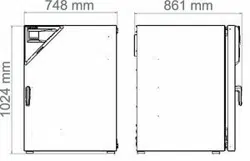Loading ...
Loading ...
Loading ...

CB-S / CB-S-UL (E7) 06/2020 page 101/119
25.2 Decommissioning
• Turn off the main power switch (2) and disconnect the chamber from the power supply (pull the power
plug).
• Turn off the CO
2
supply. Remove the gas connection.
• Let the inner chamber sufficiently cool down before removing any parts.
• The water pan must not remain filled while the incubator is out of operation. Otherwise condensation
may occur on the inner surfaces, as well as in the injection and suction nozzle of the CO
2
sensor com-
partment. If condensation formation has occurred, drops of condensate would leak from the openings
of injection and suction nozzle of the CO
2
sensor. In this case, clean and dry the incubator running at
37 °C / 98.6 °F with doors open for at least one hour before loading it with samples. BINDER recom-
mends performing a hot air sterilization of the chamber before commissioning.
• Temporal decommissioning: See indications for appropriate storage, chap. 3.3.
• Final decommissioning: Dispose of the chamber as described in chap. 25.3 to 25.5.
When restarting the chamber, please pay attention to the corresponding information in chap. 6.3.
25.3 Disposal of the chamber in the Federal Republic of Germany
According to Annex I of Directive 2012/19/EU of the European Parliament and of the Council on waste
electrical and electronic equipment (WEEE), BINDER devices are classified as “monitoring and control
instruments” (category 9) only intended for professional use“. They must not be disposed of at public col-
lecting points.
The chambers bear the symbol for the marking of electrical and electronic equipment man-
ufactured / placed on the market in the EU after 13 August 2005 and be disposed of in sep-
arate collection accordi
ng to Directive 2012/19/EU on waste electrical and electronic
equipment (WEEE) and German national law for electrical and electronic equipment (El-
ektro- und Elektronikgerätegesetz, ElektroG). WEEE marking: crossed-out wheeled bin with
solid bar under. A significant part of the materials must be recycled in order to protect the
environment.
At the end of the device’s service life, have the chamber disposed of according to the German national
law for electrical and electronic equipment (Elektro- und Elektronikgerätegesetz, ElektroG from 20 Octo-
ber 2015, BGBl. I p. 1739) or contact BINDER service who will organize taking back and disposal of the
chamber according to the German national law for electrical and electronic equipment (Elektro- und El-
ektronikgerätegesetz, ElektroG from 20 October 2015, BGBl. I p. 1739).
NOTICE
Danger of violation against existing law if not disposed of properly.
∅ Do NOT dispose of BINDER devices at public collecting points.
Have the device disposed of professionally at a recycling company which is certified
according to the German national law for electrical and electronic equipment (Elektro-
und Elektronikgerätegesetz, ElektroG from 20 October 2015, BGBl. I p. 1739).
or
Instruct BINDER Service to dispose of the device. The general terms of payment and
delivery of BINDER GmbH apply, which were valid at the time of purchasing the cham-
ber.
Certified companies disassemble waste (used) BINDER equipment in primary substances for recycling
according to Directive 2012/19/EU. The devices must be free from toxic, infectious or radioactive sub-
stances in order to eliminate any health hazards to the employees of the recycling companies.
Loading ...
Loading ...
Loading ...
